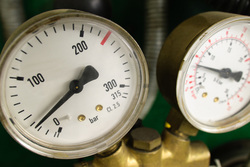
To our modern mind, the purpose of an oxygen sensor is somewhat quaint; it measures the level of oxygen present in a liquid or gas. Regardless of the quaintness, the sensor has wide-reaching applications, the most common of which most people use every day without even realizing it.
The oxygen sensor also goes by the name lambda sensor and O2 sensor.
A Brief History of the Oxygen Sensor
Created in the late 1960s, the oxygen sensor was employed as a device to attach to car’s exhaust pipe. The intent was to have a way to tell the car how much oxygen and fuel it should be mixing to aid in the combustion process.
However, now the oxygen has a wider reach of applications, although its most popular usage is still in cars.
Current Automotive Utilization of the Oxygen Sensor
Modern cars have an updated, modified version of the oxygen sensor. It monitors the exhaust for either rich or lean oxygen output, then telling the computer to mix more or less fuel as appropriate.
The goal is to be efficient with fuel use. A malfunctioning oxygen sensor that is telling the engine to use more fuel than is needed will cost you money, while one which is telling the engine to use less fuel than is needed will result in unsatisfactory performance. If that is the case, after testing an oxygen sensor, you might have to replace your oxygen sensor.
The Medical Oxygen Sensor
Of course, a device that can specifically monitor oxygen within liquid or gas has a wide reach of applications. The medical field is a prime example of using this technology to help people. Obvious applications include monitoring a patient’s breathing, delivery of anesthesia and other gases, incubators, etc.
Other Uses of Oxygen Sensors
Oxygen tanks used by divers have a sensor. They are used in beer making to ensure proper carbonation—especially with dissolved oxygen sensors. Hypoxic air fire prevention systems are built with the recognition that oxygen is required for fire, and so with an oxygen sensor they can keep the level of oxygen low.
While utilization, replacement, and testing of an oxygen sensor varies depending on the industry, however, one thing remains constant: ensuring proper oxygen levels within a liquid or gaseous substance. Without these sensors our cars would not operate right, our medical equipment would be less precise, and our beer would be less awesome.
The oxygen sensor also goes by the name lambda sensor and O2 sensor.
A Brief History of the Oxygen Sensor
Created in the late 1960s, the oxygen sensor was employed as a device to attach to car’s exhaust pipe. The intent was to have a way to tell the car how much oxygen and fuel it should be mixing to aid in the combustion process.
However, now the oxygen has a wider reach of applications, although its most popular usage is still in cars.
Current Automotive Utilization of the Oxygen Sensor
Modern cars have an updated, modified version of the oxygen sensor. It monitors the exhaust for either rich or lean oxygen output, then telling the computer to mix more or less fuel as appropriate.
The goal is to be efficient with fuel use. A malfunctioning oxygen sensor that is telling the engine to use more fuel than is needed will cost you money, while one which is telling the engine to use less fuel than is needed will result in unsatisfactory performance. If that is the case, after testing an oxygen sensor, you might have to replace your oxygen sensor.
The Medical Oxygen Sensor
Of course, a device that can specifically monitor oxygen within liquid or gas has a wide reach of applications. The medical field is a prime example of using this technology to help people. Obvious applications include monitoring a patient’s breathing, delivery of anesthesia and other gases, incubators, etc.
Other Uses of Oxygen Sensors
Oxygen tanks used by divers have a sensor. They are used in beer making to ensure proper carbonation—especially with dissolved oxygen sensors. Hypoxic air fire prevention systems are built with the recognition that oxygen is required for fire, and so with an oxygen sensor they can keep the level of oxygen low.
While utilization, replacement, and testing of an oxygen sensor varies depending on the industry, however, one thing remains constant: ensuring proper oxygen levels within a liquid or gaseous substance. Without these sensors our cars would not operate right, our medical equipment would be less precise, and our beer would be less awesome.
